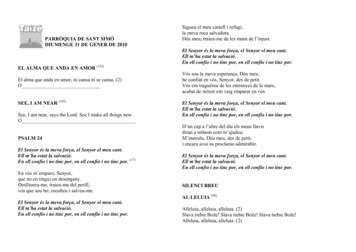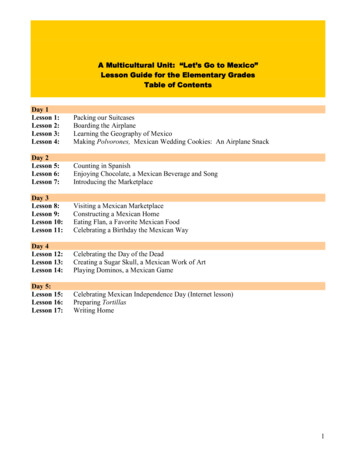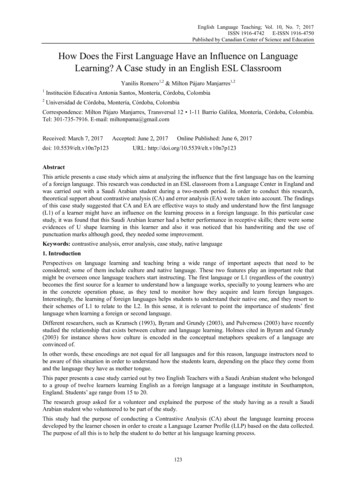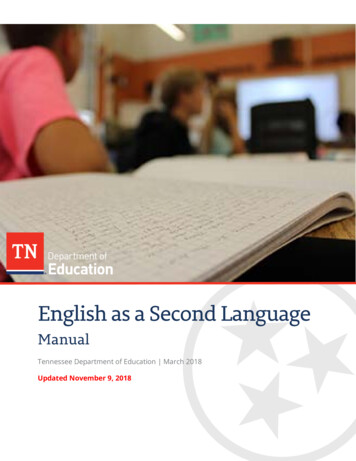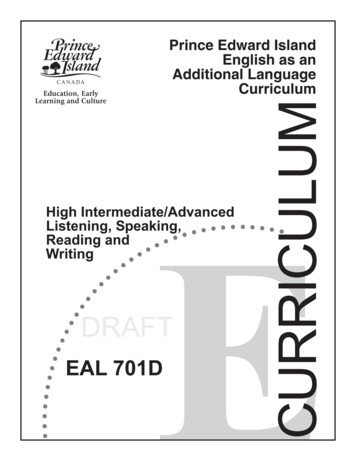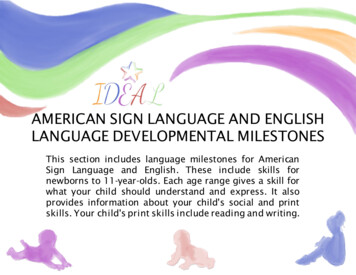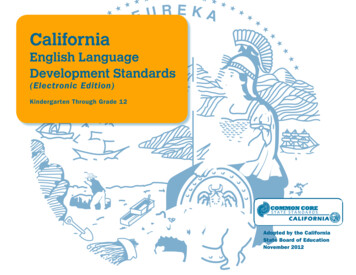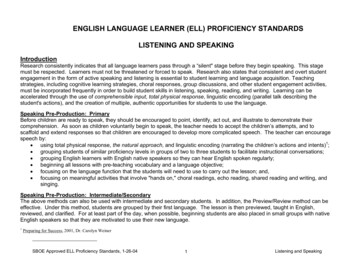
Transcription
ENGLISH LANGUAGE LEARNER (ELL) PROFICIENCY STANDARDSLISTENING AND SPEAKINGIntroductionResearch consistently indicates that all language learners pass through a “silent" stage before they begin speaking. This stagemust be respected. Learners must not be threatened or forced to speak. Research also states that consistent and overt studentengagement in the form of active speaking and listening is essential to student learning and language acquisition. Teachingstrategies, including cognitive learning strategies, choral responses, group discussions, and other student engagement activities,must be incorporated frequently in order to build student skills in listening, speaking, reading, and writing. Learning can beaccelerated through the use of comprehensible input, total physical response, linguistic encoding (parallel talk describing thestudent's actions), and the creation of multiple, authentic opportunities for students to use the language.Speaking Pre-Production: PrimaryBefore children are ready to speak, they should be encouraged to point, identify, act out, and illustrate to demonstrate theircomprehension. As soon as children voluntarily begin to speak, the teacher needs to accept the children’s attempts, and toscaffold and extend responses so that children are encouraged to develop more complicated speech. The teacher can encouragespeech by: using total physical response, the natural approach, and linguistic encoding (narrating the children’s actions and intents)1; grouping students of similar proficiency levels in groups of two to three students to facilitate instructional conversations; grouping English learners with English native speakers so they can hear English spoken regularly; beginning all lessons with pre-teaching vocabulary and a language objective; focusing on the language function that the students will need to use to carry out the lesson; and, focusing on meaningful activities that involve "hands on," choral readings, echo reading, shared reading and writing, andsinging.Speaking Pre-Production: Intermediate/SecondaryThe above methods can also be used with intermediate and secondary students. In addition, the Preview/Review method can beeffective. Under this method, students are grouped by their first language. The lesson is then previewed, taught in English,reviewed, and clarified. For at least part of the day, when possible, beginning students are also placed in small groups with nativeEnglish speakers so that they are motivated to use their new language.1Preparing for Success, 2001, Dr. Carolyn WeinerSBOE Approved ELL Proficiency Standards, 1-26-041Listening and Speaking
ELL IPerformance Conditions: Students at this stage comprehend simple statements and questions. They understand the general idea of basicmessages and conversations that pertain to common, routine matters. Their interactions are short, face-to-face, informal, and with one personat a time or in small groups. Although students can initiate and respond to basic statements, their speech is largely guided by questions andfeedback from the teacher. English learners rely heavily on repetition, gestures, and other nonverbal cues to sustain conversations. Theirspeech is slow. Communications that students listen to and comprehend are short and include familiar routine words. Context stronglysupports their utterances.Delivery of OralBeginningEarly IntermediateIntermediateEarly AdvancedAdvancedCommunicationsThe student will:The student will:Standard:The student willexpress orally his orher own thinking andideas. Respond togreetings with simplewords, gestures, andother nonverbalbehavior. Use common socialgreetings and simplerepetitive phrases usingisolated words or stringsof 2- to 3-word responses(e.g., Hello. How areyou? Thank you. You’rewelcome.)The student will:The student will:Respond to and initiategreetings, courtesy, andleave-taking, and providebasic personal informationrelated to the context ofthe conversation with keywords and short phrases(e.g., name, address,age). Respondappropriately to mostsocial interactions,including introducingself, asking about theother, and respondingto questions aboutpersonal information,using phrases andsome simplesentences. The student will: Participate in smallgroup discussions,including greetingfamiliar and unfamiliarpeople, respondingappropriately tointroductions by otherpeople, and asking andresponding to detailedquestions regardingpersonal information,using phrases andsimple sentences.(LS-R3, LS-R5) Use gestures tocommunicate basicneeds (e.g., pointstoward door whenneeding to go to therestroom). Use more utterancesaccompanied by gesturesto indicate basic needs(e.g., says “bathroom”while pointing toward thedoor).SBOE Approved ELL Proficiency Standards, 1-26-04 Communicate in alimited way some basicimmediate personal andsurvival needs withoutnecessarily usingpurposeful, yet restricted,vocabulary (e.g., I’mhungry.)2 Communicateimmediate personaland survival needs,using accurate andsomewhat variedvocabulary. Communicateimmediate and futurepersonal and survivalneeds, using precise,descriptive, and variedvocabulary.* Correlated to theReadiness level forKindergarten.Listening and Speaking
ELL IDelivery of OralCommunicationsStandard:The student willexpress orally his orher own thinking andideas. BeginningEarly IntermediateIntermediateEarly AdvancedAdvancedThe student will:The student will:The student will:The student will:The student will:Identify by name afew familiar objects,people, and events(e.g., family members,body parts, clothing,pets, foods, commonoccupations, seasons,common school,classroom, and homeobjects). Identify by namesome familiar objects,people, and events(e.g., family members,body parts, clothing,pets, foods, commonoccupations, seasons,common school,classroom, and homeobjects). Identify by namemany familiar objects,people, and events(e.g., family members,body parts, clothing,pets, foods, commonoccupations, seasons,common school,classroom, and homeobjects). Describe immediatesurroundings, such asclassroom, school, orhome. Retell simple storiesin a logical sequence,using key words,phrases, and simplesentences. Recite simple,familiar rhymes andsongs with expressivephrasing andintonation.SBOE Approved ELL Proficiency Standards, 1-26-04Recite familiarrhymes, songs, andstories with clear,audible, and expressivephrasing andintonation.3Describe familiarobjects, people, andevents with bothgeneral and morespecific words andphrases.Retell simple storiesin a logical sequence,using expressivephrasing. (LS-R1)* Correlated to theReadiness level forKindergarten.Listening and Speaking
ELL IStandard EnglishConventionsStandard:The student willidentify, describe, andapply conventions ofstandard English inhis or hercommunications.BeginningEarly IntermediateIntermediateEarly AdvancedAdvancedThe student will:The student will:The student will:The student will:The student will:Speak in isolatedwords (usually a singlenoun or verb),depending heavily ongestures to expressmeaning. Speak in isolatedwords or strings of 2 to3 words, depending ongestures to expressmeaning.Speak in shortphrases and simplesentences usingEnglish grammaticalstructures and linguisticforms outlined in theAdvanced Level withsome errors, althoughthe errors do notimpedecommunication. Speak in shortphrases and simplesentences, using thefollowing Englishgrammatical structuresand linguistic formswith occasional errors:verb tenses (presenttense, including “tobe,” presentprogressive, andfuture tenses,imperatives, modalauxiliaries);possessiveadjectives andsubject pronouns,including articles;and,prepositions of timeand place; adverbsof time andfrequency. Speak in shortpatterns of words andphrases using Englishgrammatical structuresand linguistic formsoutlined in theAdvanced Level withhabitual errors thatsometimes impedecommunication. * Correlated to theReadiness level forKindergarten.SBOE Approved ELL Proficiency Standards, 1-26-044Listening and Speaking
ELL IComprehension ofOral CommunicationsStandard:The student will listenactively to the ideasof others in order toacquire newknowledge.BeginningEarly IntermediateIntermediateEarly AdvancedAdvancedThe student will:The student will:The student will:The student will:The student will: Comprehend alimited number ofcommon words andsimple phrases inconversations held ontopics of personalrelevance (e.g., basicgreetings andcourtesies) whenspoken slowly and withextensive rephrasing,repetitions, andcontextual clues. Comprehend a fewcommon words andsimple phrases inconversations on topicsof personal relevance(e.g., social courtesies,basic needs), whenspoken slowly withfrequent rephrasing,repetitions, andcontextual clues. Comprehend somewords, phrases, andshort sentences inconversations on topicsof personal relevance(e.g., social courtesies,personal information,basic needs, abilities)when spoken slowly withsome rephrasing,repetitions, andcontextual clues. Comprehend manywords, phrases, andsentences in sustainedconversations on topicsof personal relevancewhen spoken at anormal rate with somerephrasing, repetitions,and contextual clues. Comprehend andfollow simple routineinstructions forclassroom activities thatdepend on gestures andother contextual clues(e.g., “Let’s form a linefor lunch.”) Comprehend andfollow short routineinstructions (2- to 5word phrases) forclassroom activities inthe presence of gesturesand clear contextualclues. Comprehend andfollow multiple stepinstructions forclassroom activities inthe presence of gesturesand clear contextualclues. Comprehend andfollow routine (2- to 3step) instructions forclassroom activitiesin the presence ofgestures and clearcontextual clues.Listen attentively tosimple, short readaloud stories andidentify key details.Comprehend a wideranging number ofwords, phrases, andsentences in sustainedconversations on topicsof personal relevancewhen spoken at anormal rate with somerephrasing, repetitions,and contextual clues.Comprehend andfollow common positiveand negativecommands andrequests. (LS-R2)Listen attentively tosimple read-aloudstories, poems, andinformational text andidentify key details andspecific facts. (LS-R4)* Correlated to theReadiness level forKindergarten.SBOE Approved ELL Proficiency Standards, 1-26-045Listening and Speaking
ELL IIPerformance Conditions: English learners at this stage of proficiency comprehend basic vocabulary and grammatical structures in face-to-faceconversations with one person at a time or in a familiar supportive group. Topics are familiar and about common routine matters. Listeningcommunications are short monologues and dialogues on familiar routine topics delivered at a slow-to-normal rate. Students rely on repetition,gestures, and other nonverbal cues to sustain conversations. Their speech is guided by specific questions when necessary. Students use wordorder accurately in simple sentences but make errors when using more complex patterns. They use the more common verb tense forms (present,past, and future) consistently but sometimes make errors in tense formation and proper selection of verbs. English learners are able to expresssome details and nuances by using appropriate modifiers. Their speech rate is slow to normal.Delivery of OralBeginningEarly IntermediateIntermediateEarly AdvancedAdvancedCommunicationsThe student will:Standard:The student willexpress orally his orher own thinking andideas.The student will:The student will:The student will:The student will: Participate in short,routine socialconversations withindividuals in which heor she exchangespersonal informationand discussespersonal needs usingaccurate but limitedvocabulary. Participate in socialconversations in pairsor in small groups inwhich he or sheexchanges personalinformation anddiscusses personalexperiences, abilities,and needs usingaccurate and somewhatlimited vocabulary. Participate in socialconversations held inpairs or in small groupsin which he or shediscusses personal likes,dislikes, wants, andfeelings; and familiarevents, problems, andsituations usingpurposeful andsomewhat variedvocabulary. Participate inexpanded socialconversations held inpairs or in small groupsin which he or shediscusses personallikes, dislikes, wants,and feelings; andfamiliar events,problems, and situationsusing accurate andvaried vocabulary. Contribute toclassroom and smallgroup academicdiscussions byasking/answering simplequestions withconsiderable hesitancydue to the need torephrase and searchfor words.Contribute toclassroom and smallgroup academicdiscussions by asking/answering simplequestions andexpressing his or herability to do or not dosomething with somehesitancy because ofthe need to rephraseand search for words.Contribute toclassroom and smallgroup academicdiscussions by asking/answering questions,agreeing/ disagreeingwith others, and makingcomparisons with somehesitancy because of theneed to rephrase andsearch for words.* Correlations to Arizona’s Academic Standards for 1st and 2nd grades are provided in the Correlation Guide.SBOE Approved ELL Proficiency Standards, 1-26-046Contribute toclassroom and smallgroup academicdiscussions by asking/answering questions,agreeing/ disagreeingwith others, and makingcomparisons withoccasional hesitancybecause of the need torephrase and search forwords.Open, develop, andclose socialconversations with smallgroups in which he orshe discusses personallikes, dislikes, wants,and feelings; familiarevents, problems, andsituations; and otherfamiliar topics usingprecise and descriptivevocabulary.Contribute toclassroom andacademic discussionsby asking/answeringquestions, agreeing/disagreeing with others,making comparisons,and expressing interestsand preferences relatedto class projects anddiscussions. (LS-F3)* Correlated to theFoundations level for3rd grade.Listening and Speaking
ELL IIDelivery of OralCommunicationsBeginningEarly IntermediateIntermediateEarly AdvancedAdvancedThe student will:The student will:The student will:The student will:The student will:Standard:The student willexpress orally his orher own thinking andideas.(continued) Greet and take leave Role-play a Interact with adultsand peers in formaland informal settings,using English insocially and culturallyappropriate ways Use English and hisor her native languageappropriately in amultilingual socialsituation (e.g.,cooperative gamesand activities). Ask and respond toquestions about thesimilarities anddifferences in people,objects, events, andsituations in somedetail, using naturaland varied vocabulary. Issue single-step Issue 1- to 2-stepdirections androutine directions in acommands in a manner manner that thethat the listener canlistener can follow.follow, with lessreliance on gestures toconvey meaning. Issue 2- to 3-steproutine directions in amanner that thelistener can follow. in socially andculturally appropriateways.telephone conversationwith others, usingEnglish in socially andculturally appropriateways. Describe a person,object, or situation insome detail. Ask and respond toquestions about thesize, color, shape,physical characteristics,and number of familiarobjects, using accurateand somewhat limitedvocabulary. Issue 2- to 3-wordbasic, routine directionsand commands in amanner that the listenercan follow, althoughmeaning may beconveyed by gestures. Answer basicquestions about readaloud stories with 1- or2-word responses.Retell simple storiesin a logical sequence,using key words,phrases, and simplesentences.Ask and respond toquestions about variousattributes of people,objects, events, andsituations, usingpurposeful andsomewhat variedvocabulary. Relate simple storiesor events aboutpersonal experiences,using logicalorganization and somedescriptive words.* Correlations to Arizona’s Academic Standards for 1st and 2nd grades are provided in the Correlation Guide.SBOE Approved ELL Proficiency Standards, 1-26-047Relate simple storiesor events about routineactivities, using logicalorganization and naturaland varied vocabulary.Give and receivecompliments, showgratitude, and expressapologies in sociallyand culturallyappropriate waysthrough verbal andnonverbal means.Describe people,objects, events, andsituations in detail (e.g.,location, appearance,function, actions), usingprecise and descriptivevocabulary.Issue multiple-steproutine directions andinstructions in a mannerthat the listener canfollow, including basicreferences to time,location, andmovement. (LS-F2)Present coherentpersonal narrative aboutideas, events, oractivities of interest thatinclude an introduction,development, andconclusion that listenerscan follow. (LS-F3)Listening and Speaking
ELL IIStandard EnglishConventionsStandard:The student willidentify, describe,and applyconventions ofstandard English inhis or hercommunications. BeginningEarly IntermediateIntermediateEarly AdvancedAdvancedThe student will:The student will:The student will:The student will:The student will:Speak, withsatisfactory control overEnglish grammaticalstructures and linguisticforms outlined in theearlier stage ofproficiency (ELL I);however, errors andpronunciation difficultiesstill may impedecommunication. Speak, using Englishgrammatical structuresand linguistic formsoutlined in theAdvanced Level (and inELL I); however, manyerrors or irregular formsoften impedecommunication. Speak, using Englishgrammatical structuresand linguistic formsoutlined in theAdvanced Level (and inELL I); however,habitual errorssometimes impedecommunication.* Correlations to Arizona’s Academic Standards for 1st and 2nd grades are provided in the Correlation Guide.SBOE Approved ELL Proficiency Standards, 1-26-048 Speak, using Englishgrammatical structuresand linguistic formsoutlined in theAdvanced Level (and inELL I); however, someerrors occur, althoughthey do not impedecommunication. Speak in phrasesand sentences, usingthe following Englishgrammatical structuresand linguistic formswith occasional errors:verb tenses (past andpast progressivetenses, modalauxiliaries);subject-verbagreement;complete sentences;comparative andsuperlative structures;pronouns,antecedents, pronounsin the possessive,objective, anddemonstrative forms;and,prepositions ofdirection and motion;adverbs of mannerand sequence(quickly, finally).* Correlated to theFoundations level for3rd grade.Listening and Speaking
ELL IIComprehension ofOralCommunicationsStandard:The student willlisten actively to theideas of others inorder to acquire newknowledge.BeginningEarly IntermediateIntermediateEarly AdvancedAdvancedThe student will:The student will:The student will:The student will:The student will: Comprehend keywords, formulaicphrases, and most shortsentences in simplepredictableconversations on topicsof immediate personalrelevance (e.g., basicsocial interactions,needs, warnings) whenspoken slowly withfrequent rephrasing,repetitions, andcontextual clues. Comprehend a rangeof expressions used torequest personaldetails, direct classroomactivities, identifypeople, objects, andevents, and askfor/grant permissionwhen spoken slowlywith some rephrasing,repetitions, andcontextual clues. Comprehend andfollow short predictablediscourse on familiarmatters, includingfamiliar events, routines,objects, and people;likes, dislikes, wants,and feelings; and,invitations and apologieswhen spoken slowly withsome rephrasing,repetitions, andcontextual clues. Comprehend andfollow short predictablediscourse on familiarmatters, includingfamiliar events, routines,objects, and people;likes, dislikes, wants,and feelings; and,invitations and apologieswhen spoken at anormal rate with somerephrasing, repetitions,and contextual clues. Comprehend andfollow short predictablediscourse on familiarmatters, includingfamiliar events,routines, objects, andpeople; likes, dislikes,wants, and feelings;and, invitations andapologies when spokenat a normal rate. Comprehend andfollow 1-step directionsrelated to the positionof one’s movement inspace, accompanied bycontextual cues andgestures. Comprehend andfollow 2- to 3-stepdirections related to theposition of one’smovement in space,accompanied bycontextual cues andgestures. Comprehend andfollow 3- to 4-stepdirections related to theposition of one’smovement in space. Comprehend andfollow 3- to 4-stepdirections related theposition, frequency,and duration of one’smovements in space. Comprehend andfollow multiple-stepdirections related to theposition, frequency,and duration of one’smovements in space.(LS-F2)* Correlations to Arizona’s Academic Standards for 1st and 2nd grades are provided in the Correlation Guide.SBOE Approved ELL Proficiency Standards, 1-26-049* Correlated to theFoundations level forrd3 grade.Listening and Speaking
ELL IIIPerformance Conditions: Students at this stage of proficiency comprehend short conversations and interactions that are face-to-face withone person at a time or in small groups. The context of the conversations is familiar or clear and predictable. English learners at this stageinitiate and sustain conversations, although they often speak with hesitation and rely on known vocabulary. Extended communicationstypically consist of a series of short, familiar structures. They rely on repetition, gestures, and other nonverbal cues to sustain conversations.Their speech rate is slow to normal. Circumstances of the oral communications range from informal to more formal occasions, and audiencesconsist of small, familiar groups. Listening communications consist of moderately short monologues and dialogues on familiar, routine topicsthat are face-to-face, or video-or audio-mediated at a slow-to-normal rate.Delivery of OralBeginningEarly IntermediateIntermediateEarly AdvancedAdvancedCommunicationsThe student will:Standard:The student willexpress orally his orher own thinking andideas. The student will:The student will:The student will:The student will:Participate in socialconversations held inpairs or in groups onhis or her basic needs,wants, feelings, andplans; and familiarevents, using accuratebut limited vocabulary. Participate in socialconversations held inpairs or in groups onimmediate and futureneeds, wants, and plans;and familiar topics ofpersonal reference,using accurate butsomewhat limitedvocabulary. Participate in socialconversations held inpairs or in groups byasking and respondingto questions, providingadvice, grantingpermission, describingpast events, andposing hypotheticals,using purposeful andsomewhat variedvocabulary. Participate in socialconversations held inpairs or in groups byasking and respondingto questions, providingadvice, grantingpermission, describingpast events, andposing hypotheticals,using accurate andvaried vocabulary. Open, develop, and Contribute toclassroom and smallgroup academicdiscussions byasking/answeringquestions and makingcomparisons withconsiderable hesitancybecause of the need torephrase and searchfor words. Contribute toclassroom andacademic discussionsby giving suggestions,describing past andproposing hypotheticalevents, and expressingintentions andpossibilities with somehesitancy because ofthe need to rephraseand search for words. Contribute toclassroom andacademic discussionsby giving suggestions,describing past andproposing hypotheticalevents, and expressingintentions andpossibilities withoccasional hesitancybecause of the need torephrase and search forwords. Contribute toclassroom and smallgroup academicdiscussions byasking/answeringquestions, agreeing/disagreeing withothers, and makingcomparisons with somehesitancy because ofthe need to rephraseand search for words.close extended socialconversations held inpairs or in groups byasking and respondingto questions, providingadvice, grantingpermission, describingpast events, and posinghypotheticals, usingprecise and descriptivevocabulary.Contribute toclassroom andacademic discussionsby giving suggestions,describing past andproposing hypotheticalevents, and expressingintentions andpossibilities, exhibitingsome ability to employcircumlocution (i.e., theability to find anotherway to say something).* Correlated to theEssentials level forth5 grade.SBOE Approved ELL Proficiency Standards, 1-26-0410Listening and Speaking
ELL IIIDelivery of OralCommunicationsStandard:The student willexpress orally his orher own thinking andideas.BeginningEarly IntermediateIntermediateEarly AdvancedAdvancedThe student will:The student will:The student will:The student will:The student will: Greet and takeleave appropriately in avariety of settings. Give and receivecompliments, showgratitude, and expressapologies in socially andculturally appropriateways through verbal andnonverbal means. Give and receivecompliments, showgratitude, apologize,and express anger orimpatience in sociallyand culturallyappropriate waysthrough verbal andnonverbal means. Determineappropriate topics forinteraction givenaudience and setting,including when it isappropriate to tell ajoke. Advise peers onappropriate verbal andnonverbal behaviorgiven the audience andsetting. Ask and respond tobasic instructionalquestions on thecontent presented(e.g., who, what,where, when, why,how), using words andphrases. Ask and respond tobasic instructionalquestions on thecontent presented(e.g., who, what,where, when, why,how), using phrasesand simple sentences. Ask and respond toinstructional questionson the contentpresented (e.g., Whatpart of the story wasmore important?) usingphrases andsentences. Ask and respond toinstructional questionson the contentpresented (e.g., Whatpart of the story wasmore important?)with more extensivedescriptive comments. Relate stories orevents about personalexperiences, usinglogical organization andsome descriptivevocabulary. (continued)Relate stories orevents about routineactivities, using logicalorganization andaccurate but limitedvocabulary.Present coherentpersonal narrativesabout ideas, events, oractivities of interest,using logicalorganization andpurposeful andsomewhat variedvocabulary.Prepare and delivera short oral report in acontent area andeffectively convey theinformation inconnected discoursewith natural and variedvocabulary.Ask and respond toinstructional questionson the contentpresented (e.g., Howdo the events of thisstory relate to yourexperiences?) withextended explanation.Prepare and delivera short oral report in acontent area andeffectively convey theinformation throughverbal and nonverbalcommunications inconnected discoursewith accurate andprecise vocabulary.(LS-E1, LS-E2)* Correlations to Arizona’s Academic Standards for 4th grade is provided in the Correlation Guide.SBOE Approved ELL Proficiency Standards, 1-26-0411* Correlated to theEssentials level forth5 grade.Listening and Speaking
ELL IIIStandard EnglishConventionsStandard:The student willidentify, describe,and applyconventions ofstandard English inhis or hercommunications.BeginningEarly IntermediateIntermediateEarly AdvancedAdvancedThe student will:The student will:The student will:The student will:The student will: Speak withsatisfactory control overthe Englishgrammatical structuresand linguistic formsdefined in earlier stagesof proficiency (ELL I-II);however, errors andpronunciationdifficulties still mayimpede communication. Speak using Englishgrammatical structuresand linguistic formsoutlined in theAdvanced Level (and inthe earlier stages ofproficiency ELL I-II);however, many errorsor irregular forms oftenimpede communication. Speak using Englishgrammatical structuresand linguistic formsoutlined in theAdvanced Level (and inthe earlier stages ofproficiency ELL I-II);however, habitualerrors sometimesimpede communication. Speak using Englishgrammatical structuresand linguistic formsoutlined in theAdvanced Level (and inthe earlier stages ofproficiency ELL I-II);however, some errorsoccur, although theydo not impedecommunication. Use phrases andsimple sentences,showing some evidenceof connected discourse(e.g., the use of wordssuch as and, but, first,next, then, because,however, therefore.)* Correlations to Arizona’s Academic Standards for 4th grade is provided in the Correlation Guide.SBOE Approved ELL Proficiency Standards, 1-26-0412Arrange phrases,clauses, and sentencesinto correct andmeaningful patterns.Speak using thefollowing Englishgrammatical structuresand linguistic forms,with occasional errors:verb tenses (presentperfect, presentperfect progressivetenses, present realconditional, habitualpast);various types ofpronouns, includingreflexive pronouns;and,simple/compoundsentences.Present informationin coherent connecteddiscourse.* Correlated to theEssentials level for5th grade.Listening and Speaking
ELL IIIComprehension ofOralCommunicationsStandard:The student willlisten actively to theideas of others inorder to acquire newknowledge.BeginningEarly IntermediateIntermediateEarly AdvancedAdvancedThe student will:The student will:The student will:The student will:The student will: Recognize topics inread-aloud storieswhen spoken slowlyand with repetitions,rephrasing, andclarifications. Restate basic factsfrom read-aloud storiesand content areapresentations withcontextual support (e.g.,graphic organizers,posters, diagrams),repetitions, rephrasing,and clarifications. Restate the factualdetails, key words andexpressions, and overallgist of read-aloudstories and content areapresentations withcontextual support,repetitions, rephrasing,and clarifications. Identify the purpose,main ideas, supportingdetails, and key wordsand expressions ofread-aloud stories andcontent areapresentations withcontextual support,repetitions, rephrasing,and clarifications. Comprehend andfollow 3- to 4-stepdirections related to theposition, frequency,and duration of one’smovements in space. Sometimescomprehend and followmultiple-stepinstructions (4 or moresteps) for familiarprocesses orprocedures. Comprehend andfollow 3- to 4-stepdirections related to theposition of one’smovements in space.* Correlations to Arizona’s Academic Standards for 4th grade is provided in the Correlation
ELL II Performance Conditions: English learners at this stage of proficiency comprehend basic vocabulary and grammatical structures in face-to-face conversations with one person at a time or in a familiar supportive gro
